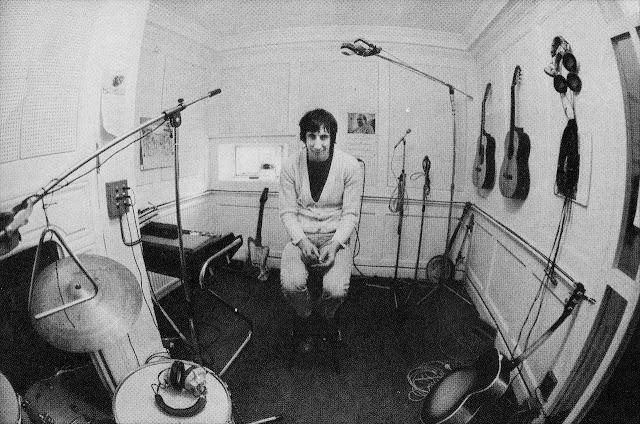Listen - Pete Townshend performs Is It In My Head?
Quadrophenia is one of the most highly praised albums of all time. It marks the end of an amazing run of four "must have albums" from The Who (preceded by Sell Out, Tommy, and Who's Next.) In 1972, as Pete began writing for Quadrophenia, Pete set out to rectify the wrongs he felt were beset upon him in his pursuit of the failed Lifehouse album, an aborted album that would become the critically acclaimed and high selling Who's Next. It seems everyone but Pete loved Who's Next. He couldn't let the failure of Lifehouse to fade and he was now set on creating another concept album. And he was also set on taking even more control of the band's direction, jettisoning extremely talented people like engineer Glynn Johns whom, Pete felt, hadn't shown enough support toLifehouse and in fact forced him to put out the best songs from that session as Who's Next.
Pete retreated to his very advanced home studio on the island of Eel Pie and shut the world out. There he tried to expand on his groundbreaking use of electronics and crafted a thematic story of a downtrodden mod named Jimmy who, like Pete, seemed to be plagued by doubt and disappointment. When Pete emerged he had a comprehensive story and two hours of demos that sounded better than many other bands' completed songs. The Who had just completed their own recording studio and Pete brought the band in to put their stamp on his sophisticated demo recordings.
Until last month, when a Deluxe, remastered and expanded addition of Quadrophenia was released, most of those demos were only rumors. We got a few on the Scoop series, but not all of them. Well, here they are. To say they are well polished is an understatement. They are rock solid. Pete's drumming and bass work have improved from his demos in preparation for the Who's Next session and his voice is more confident too. His piano work is stellar and his guitar work is often more up front than in the final mixes for The Who.
Today we highlight the song Is It In My Head? On the final Quadrophenia version, Roger Daltrey sings with anger and aggression. And it is John Entwistle whose voice is mixed to the front on the chorus. But on this demo we get to hear Pete Townshend with his more vulnerable voice. It changes the posturing of the main protagonist from one who is confrontational and defiant to one who is unsure of even his own thoughts. Listening to all the demos, one is struck by how well thought out the songs were. One is also left with the sense of how much the band was a front for Pete Townshend's mind.
In the end, the recording and mixing of Quadrophenia was not what it should have been. The studio was not in shape for the recording (it actually flooded while they recorded and the control booth had to be stationed in a bus parked outside), the technology was not there for what Pete Townshend wanted to accomplish and the band was feeling like they were taking Pete's marching orders. In addition, producing and engineering the album was probably one job too many for Pete. At night Pete would take the tapes back to his home studio and bounce tracks (making a true remaster impossible) so as to allow him to over-dub more instruments. Likewise, John Entwistle would take tapes home to record his horn sessions at his studio. It's testament to the quality of the songs and the quality of the band that the album came out as good as it did.
And it's a testament to Pete's demos.
Quadrophenia is one of the most highly praised albums of all time. It marks the end of an amazing run of four "must have albums" from The Who (preceded by Sell Out, Tommy, and Who's Next.) In 1972, as Pete began writing for Quadrophenia, Pete set out to rectify the wrongs he felt were beset upon him in his pursuit of the failed Lifehouse album, an aborted album that would become the critically acclaimed and high selling Who's Next. It seems everyone but Pete loved Who's Next. He couldn't let the failure of Lifehouse to fade and he was now set on creating another concept album. And he was also set on taking even more control of the band's direction, jettisoning extremely talented people like engineer Glynn Johns whom, Pete felt, hadn't shown enough support toLifehouse and in fact forced him to put out the best songs from that session as Who's Next.
Pete retreated to his very advanced home studio on the island of Eel Pie and shut the world out. There he tried to expand on his groundbreaking use of electronics and crafted a thematic story of a downtrodden mod named Jimmy who, like Pete, seemed to be plagued by doubt and disappointment. When Pete emerged he had a comprehensive story and two hours of demos that sounded better than many other bands' completed songs. The Who had just completed their own recording studio and Pete brought the band in to put their stamp on his sophisticated demo recordings.
Until last month, when a Deluxe, remastered and expanded addition of Quadrophenia was released, most of those demos were only rumors. We got a few on the Scoop series, but not all of them. Well, here they are. To say they are well polished is an understatement. They are rock solid. Pete's drumming and bass work have improved from his demos in preparation for the Who's Next session and his voice is more confident too. His piano work is stellar and his guitar work is often more up front than in the final mixes for The Who.
Today we highlight the song Is It In My Head? On the final Quadrophenia version, Roger Daltrey sings with anger and aggression. And it is John Entwistle whose voice is mixed to the front on the chorus. But on this demo we get to hear Pete Townshend with his more vulnerable voice. It changes the posturing of the main protagonist from one who is confrontational and defiant to one who is unsure of even his own thoughts. Listening to all the demos, one is struck by how well thought out the songs were. One is also left with the sense of how much the band was a front for Pete Townshend's mind.
In the end, the recording and mixing of Quadrophenia was not what it should have been. The studio was not in shape for the recording (it actually flooded while they recorded and the control booth had to be stationed in a bus parked outside), the technology was not there for what Pete Townshend wanted to accomplish and the band was feeling like they were taking Pete's marching orders. In addition, producing and engineering the album was probably one job too many for Pete. At night Pete would take the tapes back to his home studio and bounce tracks (making a true remaster impossible) so as to allow him to over-dub more instruments. Likewise, John Entwistle would take tapes home to record his horn sessions at his studio. It's testament to the quality of the songs and the quality of the band that the album came out as good as it did.
And it's a testament to Pete's demos.





